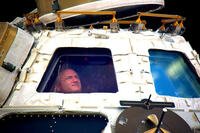The Navy has released its investigation into the underwater crash of the submarine USS Connecticut, concluding that "an accumulation of errors and omissions" committed by a "weak team" led to the service's first major submarine mishap in decades.
The heavily redacted report paints the picture of a ship led by officers who failed to learn from their mistakes and did not hold the crew to high standards. Investigators observed that "in the absence of external oversight or evaluation," the ship's leaders "failed to maintain day-to-day standards."
While on deployment in the Pacific Ocean, the Connecticut struck an unidentified seamount or underwater mountain on Oct. 2, 2021. The submarine sailed to Guam and eventually returned to its homeport of Bremerton, Washington, on Dec. 21.
Read Next: Marine Corps Considers Abandoning Parris Island Amid Rising Extreme Weather Threats
The report, submitted to Navy leaders Oct. 29 and finalized by Navy leadership on April 11, recommended nonjudicial punishments for six people: the boat's commanding officer, Cmdr. Cameron Aljilani; his second on command, Lt. Cmdr. Patrick Cashin; both of the ship's navigators; the officer of the deck ;and the junior navigator at the time of the incident. The recommended charge for all the sailors was dereliction of duty, and improper hazarding of a vessel for everyone but Cashin and the junior navigator.
Investigators suggested that "the administrative chain of command initiate detachment for cause" for all of the sailors except the junior navigator.
The ship's senior most enlisted sailor, Chief of the Boat Cory I. Rodgers, was recommended for administrative counseling.
All of the other sailors' names were redacted in the report on privacy grounds.
In the months leading up to the submarine's deployment, investigators noted that crew issues were already showing. In July 2020, the squadron that oversees all three of the Navy's advanced Seawolf-class submarines wrote Aljilani a formal "letter of performance" for "inadequate supervisory oversight, ineffective accountability practices, and superficial self-assessment.".
Then, in February 2021, Aljilani's bosses wrote him a "letter of instruction" that told him to "address the command's overall performance, lack of improvement, and reluctance to accept feedback."
Amid these troubles, the submarine hit a pier in April while mooring at Naval Base Point Loma in San Diego. The submarine did additional safety training before leaving San Diego to try and get at the failures that led to the incident, but a later investigation "revealed degraded standards in navigation, planning, poor seamanship, and ineffective command and control."
Despite this track record, the squadron decided the mooring incident "represented an anomalous performance and not systematic failure." Still, on May 25, 2021, the squadron again formally counseled the boat's commander as well as the executive officer, navigator and assistant navigator over the incident.
Two days later, on May 27, the Connecticut deployed -- ahead of schedule, according to the released report.
Much of what the submarine was doing leading up to the grounding is redacted, with the Navy citing national security reasons. The original report was classified at the Secret level -- the middle level out of three in the classification system -- and not to be shared with any foreign nationals.
The report does explain that, about a day before the crash, on Oct. 1, the sub's leadership began making plans for a "humanitarian evacuation transit" toward Okinawa. Typically, these evacuations are to offload crew who have family matters like childbirth to attend to.
The new, temporary route took the submarine over poorly surveyed areas of the ocean, something Aljilani and his navigator were aware of, according to investigators.
"[Aljilani] incorrectly believed MATT data was available and in use in the area where Connecticut was transiting," the report explained.
MATT data are classified, digital maps specifically designed for submarines. "Where MATT coverage exists, MATT is the recommended and preferred navigation product ... for subsurface navigation," the report explained. Plus, the assistant navigator knew about but didn't use a feature on the ship's digital chart system to highlight surveyed and non-surveyed areas.
"The [commanding officer] did not conduct a detailed review of the route," the report said, noting that the "temporary route passed through surveyed and unsurveyed areas on the chart."
As the ship began to take this new route, issues with the ship's depth-sensing sonar cropped up, as well. The unredacted portions of the report reveal that there were at least three separate instances during which the sailors on the bridge didn't have accurate measurements of the Connecticut's actual depth. In each of those instances, the junior sailor in charge of those readings failed to take appropriate action, investigators added.
Eventually, the team on the bridge began to note a series of discrepancies between the depth data they had from instruments and the information from the navigation charts prepared for the temporary route.
In some of the last unredacted entries before the collision, the report said that "[Aljilani] was unaware of the ship's proximity to the navigation hazard" and that "the [officer of the deck] stated he was concerned with the shallower-than-expected soundings but that he did not assess a need to take aggressive action."
"The [officer of the deck] did not consider ordering a lower speed."
The last entry said that "the sonar supervisor identified a trace near the bow" but determined it was likely an animal.
After the grounding, which the report notes occurred in international waters on the afternoon of Oct. 2, the crew reported "severe degradation" from the sonar array and took steps to surface the submarine. Once on the surface, the boat struggled to stay fully afloat since it couldn't completely empty its ballast tanks.
Eventually, the submarine was ordered to Guam, where it arrived on Oct. 8, 2021. News of the collision was first reported by USNI News the day before.
Although the Navy's initial statements and the report both note that 11 sailors were injured by the collision, the report adds more detail, including that the two most serious cases were a scalp laceration and concussion symptoms, as well as a fractured shoulder suffered by the officer of the deck at the time of the crash.
"During the transit to Guam, Connecticut identified seven Sailors who would benefit from mental health treatment," the report said. "During his interview, the [ship's corpsman] stated that number grew to approximately 50 Sailors."
The report is very tight-lipped about the damage to the submarine, redacting the entire section outlining the damage, save for a line about cost estimates being unavailable. In other sections, investigators noted that the boat's "bow dome" -- the front of the submarine that protects the sensitive sonar dome -- detached during the voyage to Guam, and divers found rocks in two of the submarine's main ballast tanks once it arrived.
The conclusions explain that while "no single action or inaction caused this mishap ... it was preventable."
"It resulted from an accumulation of errors and omissions in navigation planning, watchteam execution, and risk management," investigators added.
Specifically, the report observes that the failure to properly plan the route the day of the collision played a significant role in the mishap.
"The navigation review team, including the CO [commanding officer], failed to identify and properly mark at least ten charted hazards to navigation in the vicinity of the grounding," it said.
In addition to the navigation review team, investigators faulted the watch team at the time of the collision for not recognizing the area was hazardous and taking more actions to ensure the ship's safety. Although the report acknowledged the submarine was having issues with one of its depth-measuring sonars, investigators concluded that, even if it had been working properly, "it would not have prevented this grounding."
The blame, according to investigators, lay with several members of the Connecticut's leadership and the watch team that day.
Aljilani "failed to evaluate and mitigate risk, and he abdicated his responsibility to conduct an effective review of the voyage plan for the day of the grounding." Cashin, his second in command, "did not question the ship's voyage plan or identify watchteam errors."
The ship's two navigators were both faulted for directly contributing to the grounding. The lead navigator -- an officer -- should have reviewed the new route. Meanwhile, the assistant navigator -- a senior enlisted sailor -- "most egregiously [told a junior sailor on watch that day] to remove a 'stay out' area around a navigation hazard along the planned track."
According to a letter on the report written by the commander of the Navy's Pacific Fleet, Adm. Samuel Paparo, and dated April 11, 2022, the punishments for all six sailors blamed in the report have been carried out -- though the requests to push them from the Navy are all pending.
The letter states that the recommendation for Rodgers is complete but added that he has a pending request to be removed from the Navy, apparently suggesting that the master chief is being punished beyond what investigators recommended.
The report also suggests that the Navy look into how it trains and certifies submarine leadership, adding that "although the Connecticut [leaders] were fully qualified for their assignments, this was a particularly weak team."
A statement from the Navy on the release of these documents noted that there were a total of 28 corrective actions -- "of which 14 actions are complete, 13 actions are in progress, and 1 action is enduring."
"In implementing these significant improvements, the Navy will become a more effective fighting force," the statement added.
-- Konstantin Toropin can be reached at konstantin.toropin@military.com. Follow him on Twitter @ktoropin.
Related: Navy Sub Crews Told to Stand Down After Preventable Collision in the Pacific













